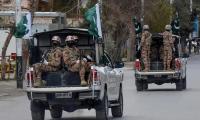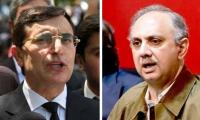In a much-hyped recent pre-budget seminar, PML-N leaders touted their government’s performance, and berated the PTI’s performance in the last three years.
Before one examines the truthfulness of the PML or PTI claims, it would be useful to briefly discuss the accuracy of economic data. One can safely assume that the following data is reasonably accurate, and easily verifiable: imports, exports, fuel imports and consumption, revenue collection and government expenditures, debt data, electricity generation and sales, banking data, and production of a few manufactured goods. All other data –GDP growth, inflation, agriculture and livestock production, service and industrial sector output, wholesale and retail prices – is subject to a wide margin of errors, mostly unverifiable and very easy to fudge.
GDP estimates are based on econometric models and assumptions and mostly unverifiable data collected through either self-reporting by firms or data collected by thousands of under-paid, incompetent and lazy low level government functionaries – daily, weekly or monthly forms filled out by these low-level functionaries are most suspect. Hence one needs to take, with a big grain of salt, much of the claims by politicians on GDP estimates and inflation. When any number has a decimal trying to convey great accuracy, especially a GDP growth number, it should raise red flags.
Another aspect that citizens need to keep in mind when evaluating any government’s economic performance, is that once an economic crisis erupts, it takes at least 1-2 years for the economy to bounce back. All developing countries that have experienced a serious economic crisis had to first undergo a stabilization period to get out of the deep hole before they could get back on the growth path. Pakistan’s own experience over the last two decades – the three balance of payments crises, after the nuclear detonations and at the end of the Musharraf and PML-N governments – clearly show that growth only picks up 1-2 years after the crisis. With that background, what can one say about the claims made by the PML-N during the five years it was in power.
Despite the ‘war on terror’, the PTI’s dharna, and tensions with the establishment, the PML-N government did a good job at stabilizing the economy and following a reasonably prudent fiscal policy during the first three years. The tax-to-GDP ratio increased by over 2.5 percent, and the fiscal deficit was brought down from around 8 percent of GDP in FY 12 to around 5 percent in the first three years. It fast tracked CPEC projects which contributed significantly to increasing growth from under 3 percent in FY 12 to just over 5 percent in FY 17. The good story, however, ends here.
The PML-N pursued some very reckless policies, especially in its last two years, which sowed the seeds of the meltdown in 2018. It insanely followed a fixed exchange rate policy for five years. As a result, exports stagnated and then declined in the last two years, and the trade deficit increased dramatically to reach a whopping $37 billion in FY 18. In its last year, the PML-N government forced the State Bank of Pakistan to spend $8-10 billion of reserves to defend the fixed exchange rate policy.
The PML-N’s development spending was lopsided and based on imprudent borrowing. It spent lavishly on highways and motorways rather than human development, and on establishing overly excessive thermal generation based on imported fuel rather than renewable energy (hydro, solar, wind). Its spending was not driven by the priority needs of the economy but by personal whims, and money-making schemes – if the PTI’s narrative were to be believed. No doubt Pakistan was facing high levels of loadshedding. However, a more sensible and affordable policy would have been to manage load and fast track renewable (especially hydro) energy projects. All the imported fuel power projects are now a tight noose around Pakistan, and a significant cause of Pakistan’s economic crisis, because of high tariffs and payments for unneeded capacity.
Despite the rhetoric, the PML-N did not pursue reforms related to civil services, fiscal management, energy, SOEs and privatization, agriculture, and water. Because of inaction in these areas, the status quo became more entrenched, thereby making pursuit of reforms by future governments more complex.
All the good work and growth that the PML-N achieved in the first three years came crashing down by the time their term ended. Pakistan was facing an acute balance of payment crisis. Foreign exchange reserves were down to under three months of imports and public debt had increased by Rs12 trillion. As a minimum, rather than trumpeting half-truths PML leaders should apologize to the nation for bringing Pakistan to its knees when they left, by pursuing reckless and unsound policies in a few critical areas.
The PTI came in with a promise of change. Citizens were excited and hopeful for a better future. However, the performance on the ground has been less than satisfactory in many areas. To its credit, the PTI stabilized the economy despite the 18-month long ( and still ongoing) Covid-19 crisis. It significantly expanded the Ehsaas and Health Card programme. Its business stimulus programme was also good. The PTI’s management of the Covid crisis and the vaccination programme has been outstanding. Its focus on hydro power and exports has been a very good step. While certainly growth has picked up, the growth number – especially with two decimals – is not plausible. Beyond these achievements, the PTI’s performance has been well below promises made at election time, and repeated ad nauseam every day.
The PTI’s incompetence in many areas, its failure to tackle inflation, frequent cabinet musical chairs and changing horses mid-stream, inaction on the reform front, and excessive propensity to beg and borrow does not portend well for the future. With an eye to the elections and its falling popularity, the PTI has now started to pursue populist policies by increasing development spending through borrowed funds and delaying SOE reforms. Lavishly increasing handouts to the poor, financed from begging and borrowing, is not sustainable. Also, the PTI has been reckless in increasing borrowing when we are already deep in debt; public debt has ballooned to Rs35 trillion.
The desire of the PM to become a global leader distracts his attention from extinguishing the fires at home. The PTI has failed as a consensus builder, a necessity to manage a federation. The party’s misplaced arrogance and combative policies have further weakened the federation, and dashed hope for the following reforms that Pakistan must pursue to pull itself out of the multiple crisis and achieve sustainable growth: making agriculture and industry globally competitive, reducing wasteful water use, privatization of SOEs, cutting waste in government and reducing debt, raising taxes and revising NFC, spending significantly more on human development, and the civil services.
Today the PTI will be announcing its fourth budget, which will no doubt make tall claims. But it will lack credibility if the past three years are any guide. If the ruling party continues to soft-peddle critical reforms and further increases debt, Pakistan will face a balance of payment crisis when the next government takes office in 2023 – similar to the crisis in 2008, 2013 and 2018.
In conclusion, Pakistan was in deep trouble when the PML-N’s term ended. It could again be in a serious crisis soon, unless the PTI improves its performance by focusing on action and not hype.
The writer is a former adviser to the World Bank.
MPAs ask for their salaries and benefits to be at par with high court judges and exempt from tax
This system fosters and places premium on VIPs, facilitating VIP culture, which is alive and kicking
Imagine this waste covering over 15,500 cricket stadiums, piled three meters deep every year
If there is one thing that can be gleaned from politics today, it is that we no longer speak same language
Postman argues that “typographic mind” was yielding to “televisual mind”
Pakistan is well poised to meet opportunities that Artificial Intelligence will offer for developments in industries







